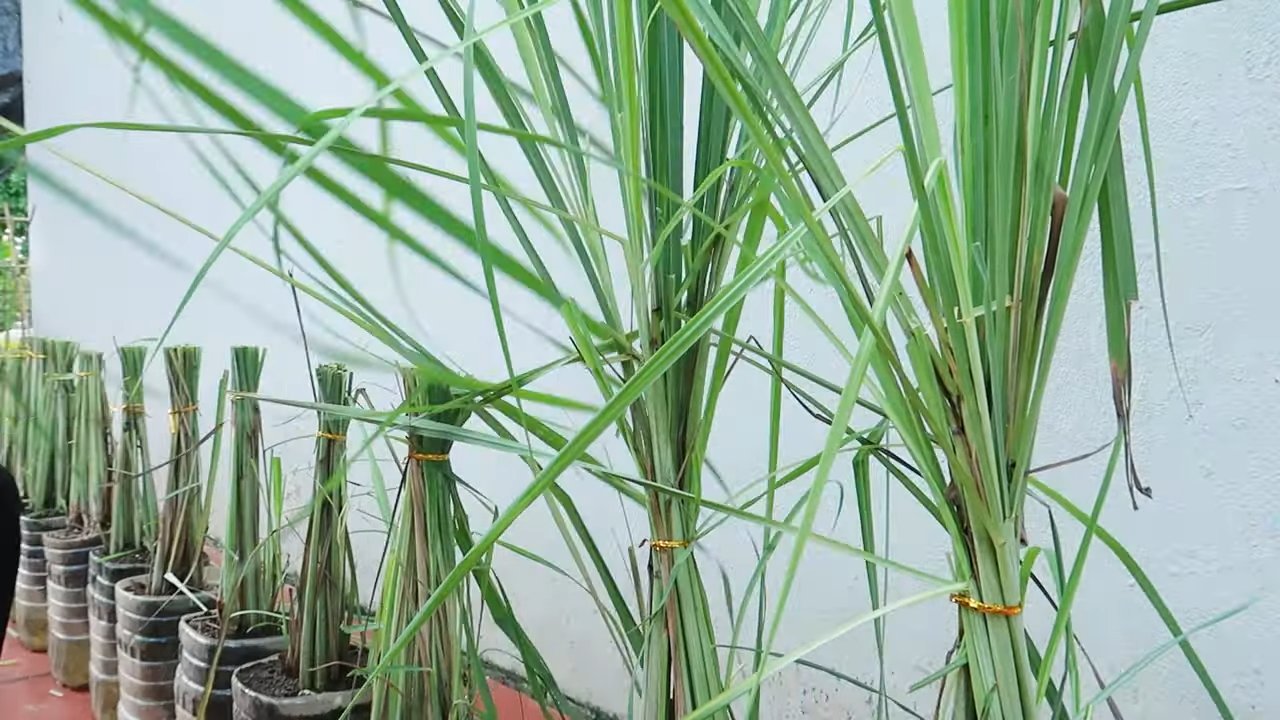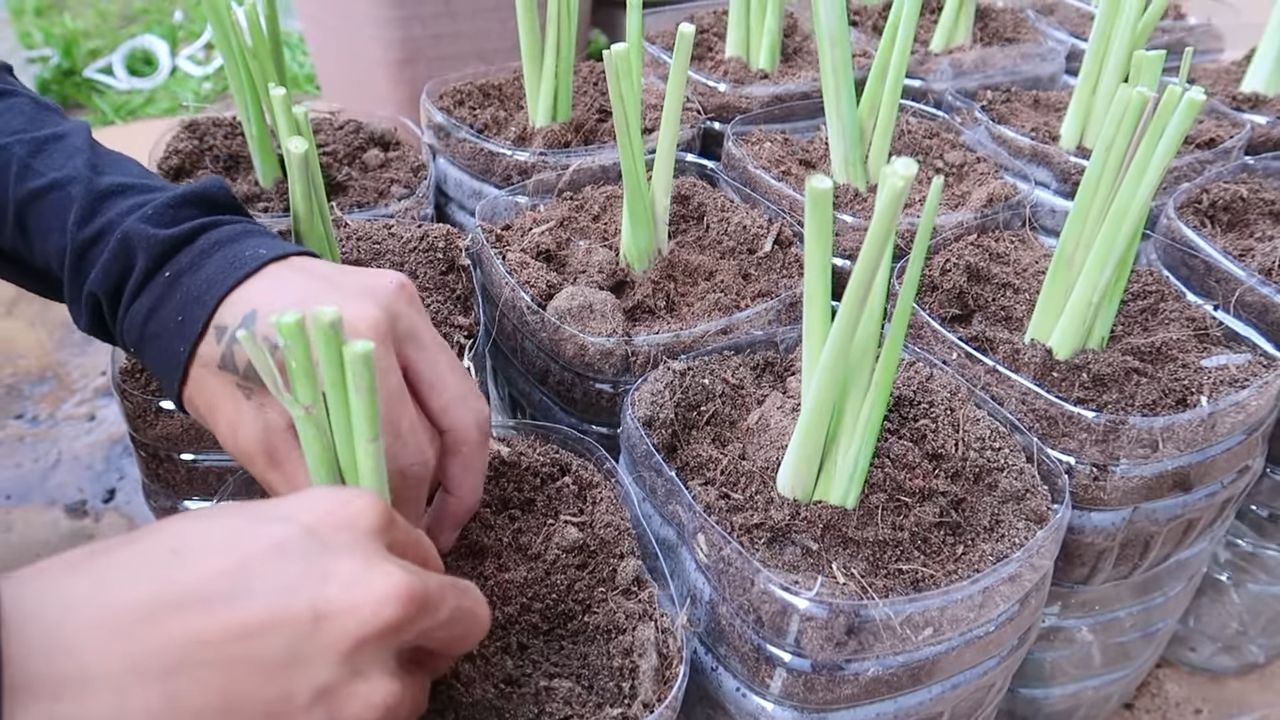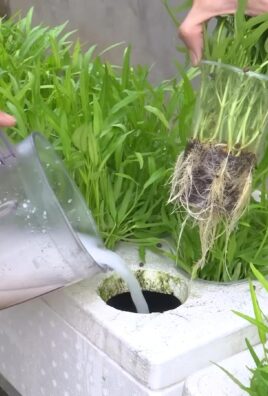Growing Lemongrass at Home can seem like a tropical dream, especially if you’re not living in a balmy climate. But what if I told you that you could easily cultivate this fragrant, flavorful herb right in your own backyard, or even on your windowsill? Imagine stepping outside to snip fresh lemongrass for your Thai curry, or brewing a soothing tea with leaves you nurtured yourself – sounds amazing, right?
Lemongrass, with its vibrant citrusy aroma, has been a staple in Asian cuisine and traditional medicine for centuries. Originating in Southeast Asia, it’s revered not only for its culinary uses but also for its potential health benefits, from aiding digestion to reducing anxiety. For generations, families have passed down secrets for successfully growing this versatile plant, and now, I’m excited to share some of those tips and tricks with you!
In today’s fast-paced world, many of us are seeking ways to connect with nature and embrace a more sustainable lifestyle. Growing Lemongrass at Home offers a fantastic opportunity to do just that. Not only will you have a readily available supply of fresh herbs, but you’ll also experience the satisfaction of nurturing a plant from start to finish. Plus, let’s be honest, store-bought lemongrass can sometimes be a bit… lackluster. With these DIY tricks, you’ll be enjoying the freshest, most flavorful lemongrass imaginable. So, let’s dive in and unlock the secrets to successfully growing lemongrass at home!

Growing Lemongrass at Home: A Comprehensive DIY Guide
Hello dear garden friends! Have you ever wondered how you can easily grow this aromatic herb at home that enhances so many Asian dishes? Lemongrass is not only incredibly versatile in the kitchen but also relatively easy to care for. I’ll show you how to grow your own lemongrass with a few simple steps. Let’s get started!
What you need: The ingredient list for your lemongrass success
Before we start, here is a list of the things you will need:
- Lemongrass stalks: Preferably from an Asian market or a well-stocked supermarket. Make sure the stalks look healthy and still have a small root base.
- A glass or a vase: For rooting.
- Water: Preferably filtered or stale.
- A planter: With good drainage. The size depends on how many stalks you want to plant.
- Potting soil: A well-draining, nutrient-rich soil is ideal.
- Fertilizer: An organic fertilizer or compost is perfect for promoting growth.
- A sunny location: Lemongrass loves the sun!
- Patience: Rome wasn’t built in a day, and neither is your lemongrass!
Phase 1: Rooting – The foundation for your lemongrass
Rooting is the most important step to ensure that your lemongrass grows well. Don’t worry, it’s easier than it sounds!
- Preparing the stalks: Cut back the upper, green leaves of the lemongrass stalks to about 5-7 cm in length. This helps the plant to concentrate its energy on root formation.
- Soaking in water: Place the prepared stalks in a glass or vase with water. Make sure that the bottom 2-3 cm of the stalks are in the water. Change the water every 1-2 days to prevent rotting.
- Waiting and observing: Place the glass in a bright, but not directly sunny, place. After about 1-2 weeks, small roots should form. Be patient, sometimes it takes a little longer!
Phase 2: Planting – Your lemongrass is moving
Once the roots are about 2-3 cm long, it’s time to plant your lemongrass.
- Preparing the planter: Fill the planter with potting soil. Make sure it has good drainage to prevent waterlogging. A layer of pebbles or clay shards at the bottom of the pot helps with this.
- Planting the stalks: Make small holes in the soil large enough to accommodate the roots of the lemongrass stalks. Carefully insert the stalks and cover the roots with soil. Press the soil down lightly.
- Watering: Water the freshly planted lemongrass thoroughly. Make sure the soil is moist, but not wet.
Phase 3: Care – So your lemongrass thrives magnificently
Proper care is crucial for your lemongrass to grow healthy and strong.
- Location: Lemongrass loves the sun! Place the planter in a sunny location where it gets at least 6 hours of sunlight per day.
- Watering: Water your lemongrass regularly, especially during the growing season (spring and summer). The soil should always be slightly moist. Avoid waterlogging, as this can lead to root rot. In winter, when growth is slower, reduce watering.
- Fertilizing: Fertilize your lemongrass every 2-4 weeks with an organic fertilizer or compost. This promotes growth and ensures strong, aromatic leaves.
- Cutting: Cut back the leaves regularly to stimulate growth. You can use the cut leaves for cooking or dry them to use as tea later.
- Overwintering: Lemongrass is not winter-hardy. If you live in a region with cold winters, you should bring the planter indoors before the first frost. Place it in a bright, cool place and reduce watering.
Additional tips and tricks for your lemongrass success
- Pest prevention: Lemongrass is relatively resistant to pests. Occasionally, aphids or spider mites can settle in. You can combat these with a jet of water or a mild soap solution.
- Propagation: You can also propagate your lemongrass by division. Dig up the plant in the spring and divide the root ball into several parts. Then plant the individual parts in separate pots.
- Harvesting: You can harvest the stalks as soon as they are about 30 cm long. Cut the stalks at the base. The plant will continue to grow and produce new stalks.
- Use: Lemongrass is incredibly versatile in the kitchen. You can use it in soups, curries, teas, and many other dishes. It gives food a fresh, lemony aroma.
- Lemongrass tea: Cut a few leaves and pour hot water over them. Let the tea steep for 5-10 minutes and enjoy! It is not only delicious but also healthy.
Common Problems and Solutions
- Yellow leaves: Yellow leaves can be a sign of overwatering, underwatering, or nutrient deficiency. Check the soil moisture and fertilize the plant if necessary.
- Brown leaf tips: Brown leaf tips can be caused by dry air or too little water. Spray the leaves regularly with water and make sure the soil is always slightly moist.
- Slow growth: Slow growth can be caused by too little sunlight, nutrient deficiency, or temperatures that are too cold. Place the plant in a sunnier location, fertilize it regularly, and make sure it is not too cold.
Why grow lemongrass? The advantages at a glance
- Fresh ingredients: You always have fresh lemongrass on hand when you need it.
- Cost-effective: You save money because you no longer have to buy lemongrass.
- Sustainability: You reduce your ecological footprint because you no longer have to transport food.
- Relaxation: Gardening is a great way to relieve stress and relax.
- Aromatherapy: The scent of lemongrass has a calming and refreshing effect.
I hope this guide has helped you to grow your own lemongrass at home. It’s really easier than you think! With a little patience and care, you will soon have a lush lemongrass plant that you can use for all your culinary adventures. Happy gardening!

Conclusion
So, there you have it! Growing lemongrass at home is not only achievable, but it’s also a rewarding experience that brings a touch of Southeast Asian freshness right to your kitchen. Forget those wilted, overpriced stalks at the grocery store. Imagine stepping out into your garden or onto your balcony and snipping off exactly what you need for your next culinary adventure. The vibrant aroma alone is enough to make it worthwhile, but the fresh, potent flavor of homegrown lemongrass is simply unmatched.
This DIY trick is a must-try for several reasons. First, it’s incredibly cost-effective. Once you have a starter plant or even just a few stalks from the grocery store, you can propagate new plants indefinitely. Second, it’s environmentally friendly. You’re reducing your reliance on commercially grown produce, which often involves long-distance transportation and potentially harmful pesticides. Third, it’s empowering! There’s a real sense of satisfaction that comes from nurturing a plant and harvesting its bounty.
Beyond the basic method, there are plenty of ways to customize your lemongrass growing experience. Experiment with different varieties of lemongrass, such as the East Indian or West Indian types, to discover which flavor profile you prefer. Try growing lemongrass in different types of containers, from terracotta pots to raised garden beds, to see what works best in your climate and space. You can even try companion planting lemongrass with other herbs and vegetables that benefit from its pest-repelling properties. Consider planting it near basil, tomatoes, or peppers to help keep unwanted insects at bay.
Don’t be afraid to get creative! You can also explore different methods of propagation. While rooting lemongrass in water is a popular and reliable method, you can also try propagating it directly in soil. Just make sure to keep the soil consistently moist until the roots have established.
We wholeheartedly encourage you to give this DIY trick a try. It’s easier than you might think, and the rewards are well worth the effort. Imagine the delicious curries, soups, teas, and stir-fries you’ll be able to create with your own homegrown lemongrass. Think of the money you’ll save and the satisfaction you’ll gain.
But most importantly, we want to hear about your experience! Share your tips, tricks, and successes (and even your challenges!) in the comments below. Let us know what worked for you, what didn’t, and any variations you tried. Your feedback will help other readers learn and grow their own lemongrass successfully. Together, we can create a community of passionate home gardeners who are enjoying the fresh, vibrant flavor of homegrown lemongrass. So, grab a few stalks, get your hands dirty, and start growing your own lemongrass today! You won’t regret it.
Frequently Asked Questions (FAQ)
What kind of soil is best for growing lemongrass?
Lemongrass thrives in well-draining soil that is rich in organic matter. A loamy soil is ideal, but you can amend any soil type to improve its drainage and fertility. Mix in compost, aged manure, or other organic materials to enrich the soil and provide essential nutrients. The pH level should be slightly acidic to neutral, ideally between 6.0 and 7.0. If your soil is heavy clay, consider adding sand or perlite to improve drainage.
How much sunlight does lemongrass need?
Lemongrass needs at least 6-8 hours of direct sunlight per day to thrive. Choose a sunny location in your garden or on your balcony where your lemongrass plant will receive ample sunlight. If you live in a particularly hot climate, some afternoon shade may be beneficial to prevent the leaves from scorching. If you are growing lemongrass indoors, place it near a south-facing window or supplement with grow lights.
How often should I water my lemongrass?
Lemongrass prefers consistently moist soil, but it doesn’t like to be waterlogged. Water your lemongrass plant deeply whenever the top inch of soil feels dry to the touch. During hot, dry weather, you may need to water it more frequently. Avoid overwatering, as this can lead to root rot. Ensure that your container has adequate drainage holes to prevent water from accumulating at the bottom.
When is the best time to harvest lemongrass?
You can start harvesting lemongrass once the stalks are at least 1/2 inch in diameter and about 12 inches tall. To harvest, simply cut the stalks near the base of the plant with a sharp knife. You can harvest individual stalks as needed, or you can harvest the entire plant at once. Regular harvesting encourages new growth and helps to keep the plant healthy.
How do I store harvested lemongrass?
Freshly harvested lemongrass can be stored in the refrigerator for up to two weeks. Wrap the stalks in a damp paper towel and place them in a plastic bag or container. You can also freeze lemongrass for longer storage. To freeze, chop the stalks into smaller pieces and place them in a freezer bag or container. Frozen lemongrass can be stored for up to six months. You can also dry lemongrass by hanging the stalks upside down in a cool, dry place until they are completely dry. Dried lemongrass can be stored in an airtight container for up to a year.
My lemongrass plant is turning brown. What’s wrong?
There are several reasons why your lemongrass plant might be turning brown. Overwatering or underwatering are common culprits. Check the soil moisture and adjust your watering schedule accordingly. Nutrient deficiencies can also cause browning. Fertilize your lemongrass plant regularly with a balanced fertilizer. Pests, such as spider mites or aphids, can also damage the leaves and cause them to turn brown. Inspect your plant regularly for pests and treat them accordingly. Finally, extreme temperatures can also cause browning. Protect your lemongrass plant from frost or excessive heat.
Can I grow lemongrass indoors?
Yes, you can grow lemongrass indoors, but it requires bright light and consistent moisture. Place your lemongrass plant near a south-facing window or supplement with grow lights. Water it regularly and ensure that the soil is well-draining. You may also need to increase the humidity around the plant by misting it regularly or placing it on a pebble tray filled with water.
Is lemongrass a perennial or an annual?
Lemongrass is a perennial in warm climates (USDA zones 9-11). In colder climates, it is typically grown as an annual or overwintered indoors. If you live in a cold climate, you can bring your lemongrass plant indoors before the first frost and keep it in a bright, sunny location. Water it sparingly during the winter months and resume regular watering in the spring.
How do I propagate lemongrass?
Lemongrass can be easily propagated from cuttings or divisions. To propagate from cuttings, simply cut a few stalks from the base of the plant and place them in a glass of water. Change the water every few days and wait for roots to develop. Once the roots are about an inch long, you can plant the cuttings in pots filled with well-draining soil. To propagate from divisions, carefully dig up the entire plant and divide it into smaller clumps. Each clump should have several stalks and a healthy root system. Plant the divisions in separate pots or in the garden.
Does lemongrass repel mosquitoes?
While lemongrass contains citronella, a natural mosquito repellent, it’s not as effective as citronella candles or sprays. The concentration of citronella in lemongrass is relatively low, and it needs to be crushed or bruised to release the scent. However, planting lemongrass around your patio or deck can help to deter mosquitoes to some extent. You can also crush a few leaves and rub them on your skin for a natural mosquito repellent.





Leave a Comment